Development of an Ab-Initio Quality Potential for PAH/Water systems using AI tools
THEORETICAL CHEMISTRY AND COMPUTATIONAL MODELING

Lab: LCPQ
Duration: NanoX master Internship (8 months part-time in-lab immersion)
5 months full-time internship
6 months full-time internship
Latest starting date: 08/01/2024
Localisation: Laboratoire de Chimie et Physique Quantiques (LCPQ) - FeRMI Institute
University of Toulouse 3, Building3R4
118 route de Narbonne
31062 Toulouse Cedex 09, France
Supervisors:
CUNY Jérôme jerome.cuny@irsamc.ups-tlse.fr
SIMON Aude aude.simon@irsamc.ups-tlse.fr
This research master's degree project could be followed by a PhD
Work package:
The study of interactions between polycyclic aromatic hydrocarbon (PAH) clusters and water aggregates is of great interest in atmospheric science and astrochemistry. Regarding atmospheric science, PAH molecules can become part of atmospheric aerosols and PAH clusters can be regarded as good models for such aerosols on which small molecules such as water condense and grow [1]. Regarding astrochemistry, PAHs have been of significant interest since proposal in the 1980s that they were the carriers of the aromatic infrared bands (AIBs), a set of mid-IR emission bands observed in many regions of the interstellar medium (ISM) [2]. Astronomical observations revealed the presence of nanograins inside molecular clouds as precursors of PAHs and PAH clusters were proposed as good analogs for these nanograins [3]. Small molecules such as H2O may condense on such grains, and PAH clusters with adsorbed water molecules could then be considered models for carbon nanograins in the planet- and star-forming regions.
At LCPQ, Monte-Carlo (MC) and Molecular dynamics (MD) based approaches in conjunction with an efficient electronic structure method, namely density-functional-based tight-binding (DFTB), were used to explore the potential energy surfaces (PES) of PAHm(H2O)n clusters. This allowed to gain insight into their structures, energetics as well as their spectral and dynamical properties. Clusters of water (n=1-8) on a single PAH (m=1) were the object of several finite temperature simulations to study diffusion and conformational dynamics of the water clusters on the PAH surface at low temperature [4]. These studies laid the foundations to investigate the influence of the adsorption of such clusters on a single PAH on their heat capacities [5]. Modeling the ice by a larger water cluster, the structures, energetics and ionization energies of a series of PAHs adsorbed on ice (amorphous and crystalline) were also determined [6], while the experimental shifts of the IR features of the O–H dangling bond at the surface of water ice due to the interaction with the PAH could be reproduced [7]. Global explorations of the PES of PAHm(H2O)n (PAH=pyrene, m=2, n=1-10) clusters were also recently performed and their ionization potentials were determined [8]
Despite DFTB is an efficient electronic method, some size limitations are reached. Larger clusters should indeed be considered to mimic atmospheric aeorosols, space nanograins or aggregates formed in cluster sources and trapped in low-temperature conditions. The accuracy of the intermolecular potential can also become an issue when many isomers compete, which is the case of PAHm(H2O)n clusters.
To go a step further in the modeling of PAH/water systems, we would like to develop a potential that can treat large size systems at a limited computational cost while conserving an ab-initio quality. To reach this objective, we will develop a potential based on deep neural networks (Deep Neural Network Potential; DNNP) that will be built from data produced from high quality quantum chemical calculations [9]. Thousands of structures considering various types of PAH will thus be generated and obtained under different temperature conditions. Once re-calculated at the DFT level with a high quality functional (for instance revPBE0-D3), the structures, energies and forces will constitute the training set of the DNNP potential. The exact definition of this set, the chemical descriptors, the definition of the DNNP are the parameters that will need to be defined and tested. To do this, we will use the DeePMD kit [10] specifically developed to build DNNP potentials for MD applications and which we are already using at the LCPQ.
If successful, in combination with the the i-PI code [11], MD simulations will be carried out on various PAH/water systems of increasing size to perform global optimisation and fragmentation simulations on systems which were not accessible so far due to size limitations. Fragmentation simulations will be compared to experimental measurements performed at the Laboratoire Collision Agrégats et Réactivité (LCAR) and help in rationalizing those experiments.
References:
[1] I. S. Vinklarek, A. Pysanenko, E. Pluharova, M. Farnik, J. Phys. Chem. Lett., 13, 3781 (2022).
[2] A. G. G. M. Tielens, Annu. Rev. Astron. Astrophys. 46, 289 (2008).
[3] P. Pilleri, J. Montillaud, O. Berné, C. Joblin, Astron. Astrophys. 542, A69 (2012) and refs. therein.
[4] A. Simon and F. Spiegelman, J. Chem. Phys. 138, 194309 (2013) and refs. therein.
[5] L. F. L. Oliveira, J. Cuny, M. Morini.re, L. Dontot, A. Simon, F. Spiegelman, M. Rapacioli, Phys. Chem. Chem. Phys. 17, 17079 (2015).
[6] E. Michoulier, N. Ben Amor, M. Rapacioli, J. A. Noble, J. Mascetti, C. Toubin, A. Simon, Phys. Chem. Chem. Phys. 20, 11941 (2018).
[7] E. Michoulier, C. Toubin, A. Simon, J. Mascetti, C. Aupetit, and J. A. Noble, J. Phys. Chem. C 124, 2994 (2020).
[8] H. Leboucher, A. Simon, M. Rapacioli, J. Chem. Phys. 158, 114308 (2023).
[9] M. de la Puente, R. David, A. Gomez,D. Laage, J. Am. Chem. Soc., 144, 23, 10524-10529 (2022).
[10] H. Wang, L. Zhang, J. Han, E. Weinan, Comput. Phys. Comm., 228, 178-184 (2018).
[11] V. Kali, M. Rossi, O. Marsalek et al., Comput. Phys. Comm., 236, 214-223 (2019).
Areas of expertise:
Machine Learning ; Molecular dynamics ; PAH ; Water clusters ; Fragmentation
Required skills for the internship:
Applicants must have a background in physics or chemistry and must have skills in theoretical chemistry and be interested in using computational tools. Skills in programming languages such as Bash, Python and Fortran are a plus but are not compulsory
